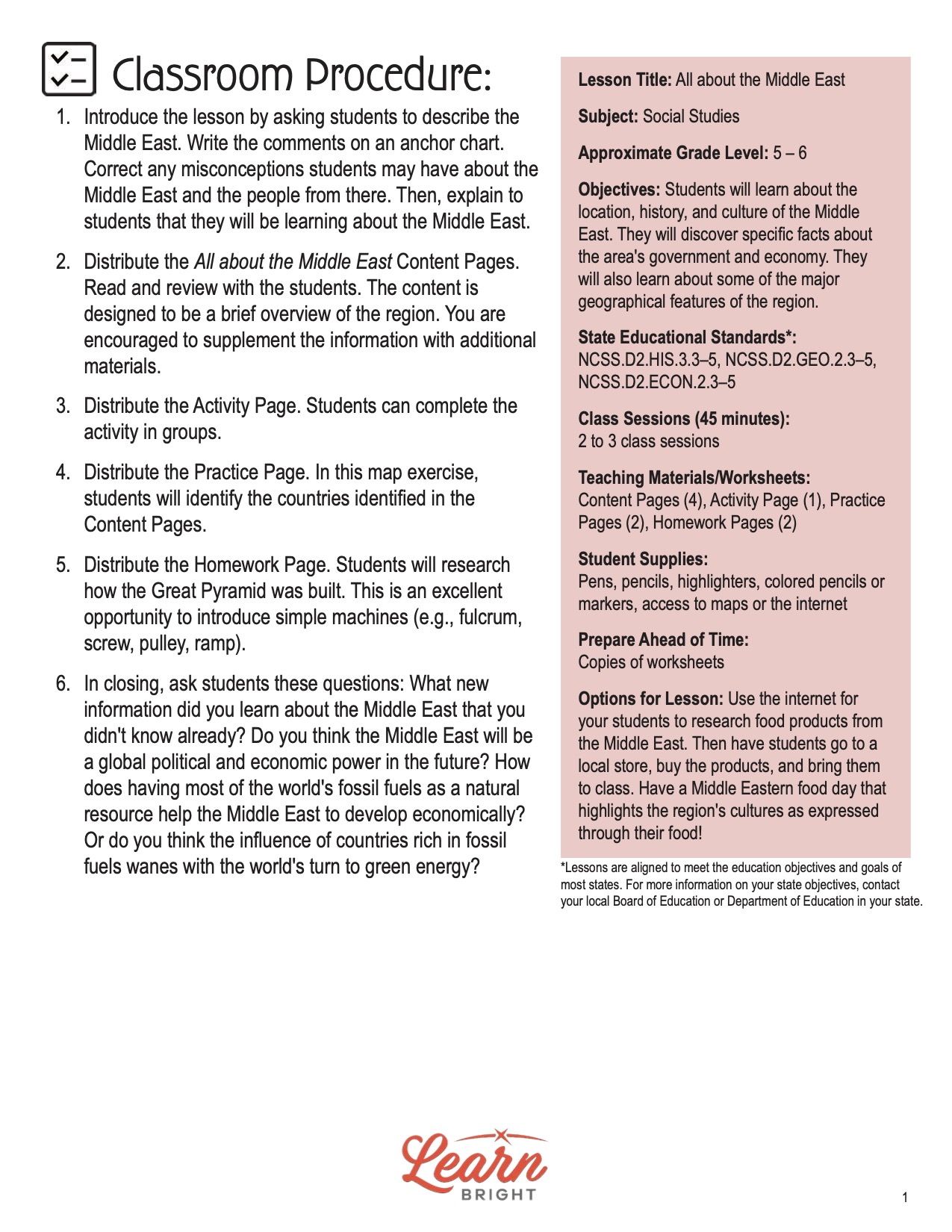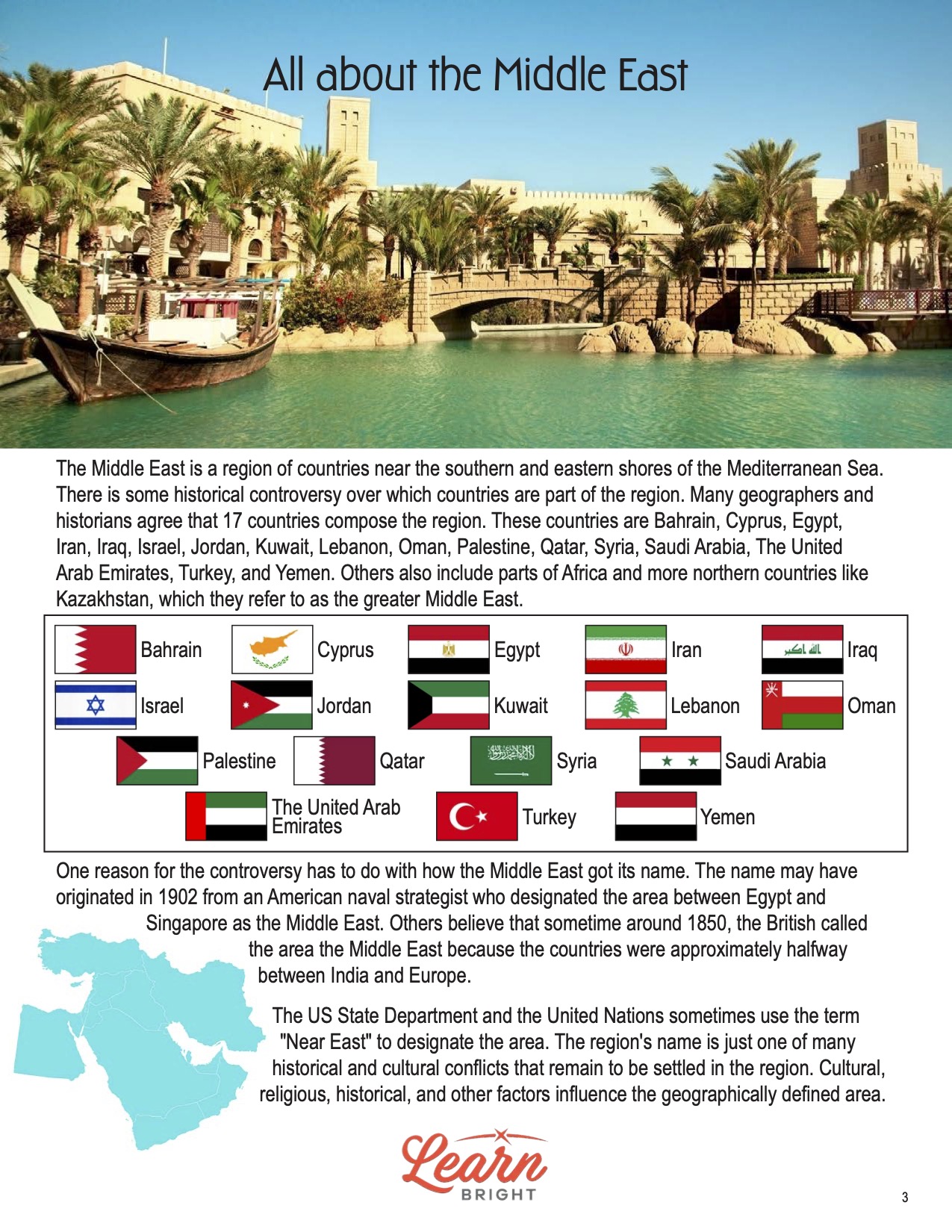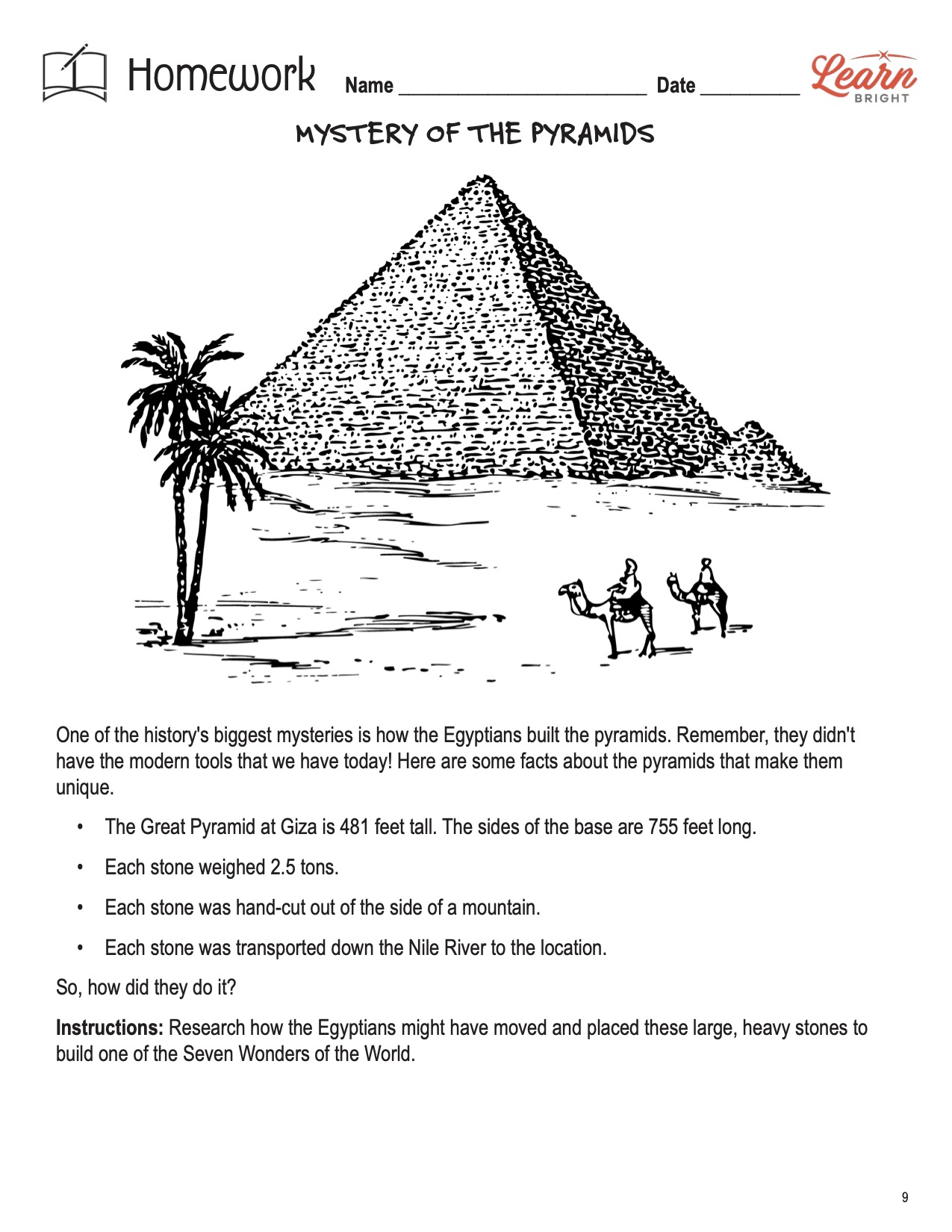Description
What our All about the Middle East lesson plan includes
Lesson Objectives and Overview: All about the Middle East introduces students to the location, history, and culture of the Middle East. They will discover specific facts about the area’s government and economy. They will also learn about some of the major geographical features of the region.
Classroom Procedure
Every lesson plan provides you with a classroom procedure page that outlines a step-by-step guide to follow. You do not have to follow the guide exactly. The guide helps you organize the lesson and details when to hand out worksheets. It also lists information in the yellow box that you might find useful. You will find the lesson objectives, state standards, and number of class sessions the lesson should take to complete in this area. In addition, it describes the supplies you will need as well as what and how you need to prepare beforehand.
Options for Lesson
In the “Options for Lesson” section of the classroom procedure page, you will see some suggestions for additional activities or ideas to add to the lesson if you want to. For this lesson, it suggests that you use the internet for your students to research food products from the Middle East. Then have students go to a local store, buy the products, and bring them to class. Have a Middle Eastern food day that highlights the region’s cultures as expressed through their food!
Teacher Notes
The paragraph on this page provides a little more information or guidance on what to expect from the lesson. It explains that this lesson is not meant to be an all-encompassing lesson on the subject. Instead, the lesson gives students an overview and basic knowledge of one of the world’s most important regions from a historical, economic, and geographic perspective. You can use the blank lines to record any thoughts or ideas you have as you prepare.
ALL ABOUT THE MIDDLE EAST PLAN CONTENT PAGES
The All about the Middle East includes four content pages. The Middle East is a region of countries near the southern and eastern shores of the Mediterranean Sea. There is some historical controversy over which countries are part of the region. Many geographers and historians agree that 17 countries compose the region. These countries are Bahrain, Cyprus, Egypt, Iran, Iraq, Israel, Jordan, Kuwait, Lebanon, Oman, Palestine, Qatar, Syria, Saudi Arabia, The United Arab Emirates, Turkey, and Yemen. Others also include parts of Africa and more northern countries like Kazakhstan, which they refer to as the greater Middle East.
One reason for the controversy has to do with how the Middle East got its name. The name may have originated in 1902 from an American naval strategist who designated the area between Egypt and Singapore as the Middle East. Others believe that sometime around 1850, the British called the area the Middle East because the countries were approximately halfway between India and Europe.
The US State Department and the United Nations sometimes use the term “Near East” to designate the area. The region’s name is just one of many historical and cultural conflicts that remain to be settled in the region. Cultural, religious, historical, and other factors influence the geographically defined area.
Geography of the Middle East
Popular culture often features the Middle East as a vast, arid desert. But that is a geographical misconception. While it is true that large portions of the Middle East are desert, the region contains a diverse set of topographical features. The area has fertile river valleys, mountainous parts, and coastal plains. Parts can even get snow.
Geographers divide the region into geographic zones separated by mountains and deserts. Each division has a distinct culture. Again, it’s important to remember that the way one defines the Middle East region determines which topographical features they would include. Generally, geographers agree that there are specific major ones. The lesson then lists several seas/oceans, lakes and rivers, and other features. This includes the Mediterranean Sea, Persian Gulf, Nile River, Suez Canal, Dead Sea, and Arabian Desert, among many others.
The climate zones of the Middle East vary. The major climate zones are semi-arid, Mediterranean, tropical, and subtropical climates. The mountain peaks are snow-capped. Temperatures range from temperate along the Mediterranean coasts to extreme heat in the deserts. As you might expect, precipitation varies widely among regions. For example, in Iraq, the average rainfall can be pretty significant near the northern coast compared with the desert areas, which receive little to no rainfall for most of the year.
History of the Region
Scientists believe hominids occupied Africa 4 million or more years ago. Hominids are the earliest known ancestors of humans. Humans appeared about 100,000 years ago in the eastern region of sub-Saharan Africa. They would later migrate north and fan out across the Middle East, then to the rest of the world.
Ancient civilizations began in the Fertile Crescent near the Euphrates, Tigris, and Nile Rivers in the Middle East. Sumer, Babylonia, and Assyria were powerful kingdoms in Mesopotamia and ancient Egypt. Around 3000 BCE, Egypt—one of the greatest kingdoms in history—appeared along the Nile River Valley.
The Middle East became home to history’s earliest and greatest kingdoms. Advances in math, astronomy, agriculture, and engineering that had never been seen before came from the Middle East. Some historians believe the Greeks and Romans borrowed ideas and technology from Middle Eastern cultures and claimed them as their own.
Religion and Conflict
Until this point in history, most cultures worshiped multiple gods (polytheism). The three Abrahamic religions (Judaism, Christianity, and Islam) that believe in one God (monotheism) originated in the Middle East. By the 12th century, Muslim faith and culture dominated the region. The Ottoman Empire arose in the 13th century, controlling the area for several centuries until its collapse.
The modern history of the Middle East involves the competition over land, fossil fuels, and religion. In recent history, there has been a continuous ebb and flow of Middle Eastern countries aligning or unaligning with European and other Western nations. One misconception about the Middle East is that the region’s governments promote terrorism or are in a perpetual civil war or conflict. While some do, at least as many, if not more, desire to live without conflict and be part of the global community.
Government and Economy
The Middle East has no single governing authority for the region. All of the countries are sovereign, independent nations. The most common type of governance is monarchy. Most are authoritarian run. Some have parliamentarian-styled governments, but like many authoritarian states, candidates are chosen from the ruling party. Elections are not free elections as they are in true democracies. Historically, countries in the Middle East have been opposed to democracy, except for Israel.
A handful of countries rely on the export of oil and gas to sustain their economy. This has led to enormous gaps in the wealth of Middle Eastern countries. Qatar, The United Arab Emirates, Saudi Arabia, and Kuwait have become some of the wealthiest countries in the world. In the future, when more of the world’s energy is produced by non–fossil fuels, it remains to be seen how this will affect their economies. Meanwhile, other countries suffer from high unemployment, poor education and healthcare, inefficient government services, and a lack of infrastructure. Some of the conflicts in the Middle East are the result of the wealth gap between neighboring countries.
In recent years, technology and the improvement of transportation have bridged the gap to some degree. With several conflicts raging throughout the Middle East, however, there is great uncertainty about the region’s future. Efforts to secure long-term peace in the area have been complex and elusive. However, the people of the Middle East are very resilient and primarily optimistic about the future of their homelands.
Culture and Modern Middle East
The Middle East is not a monolithic culture. There is incredible diversity in cultural traditions, religious practices, and ethnic diversity. There are 60 different languages spoken in the Middle East. Family is extraordinarily important in these cultures. Religion plays a prominent role in the daily lives of its citizens. And there is a stark difference between living in cities and living in rural villages.
The modern Middle East is a region in transition. The global economy and the internet have introduced Middle Easterners to Western-style fashions and goods. Young people want modern conveniences, participate in modern activities, and leave some old traditions behind. Older people are more conservative. They feel the transition replaces their conservative religious and cultural traditions. They fear the Westernization of their cultural values.
Pockets of modernism co-exist with the traditional. But it is an uneasy and uncomfortable existence. As one Middle Easterner observed, “There is an active debate in most Middle Eastern communities about how much Western culture and technology can and should be adopted before such influences begin to compromise their culture, traditions, and identity.” There are no easy answers to this question.
ALL ABOUT THE MIDDLE EAST PLAN WORKSHEETS
All about the Middle East includes three worksheets: an activity worksheet, a practice worksheet, and a homework assignment. Each one will help students solidify their grasp of the material they learned throughout the lesson. You can refer to the classroom procedure guidelines to know when to hand out each worksheet.
MIDDLE EAST PRESENTATION ACTIVITY WORKSHEET
Students will work with a partner for the activity. First, they will choose one of the 17 countries of the Middle East. They will find a map of the country to include in their presentation. Then they will include a number of other features to present to the class, such as major cities, natural resources, and at least two attractions that tourists might visit.
ALL ABOUT THE MIDDLE EAST PRACTICE WORKSHEET
For the practice worksheet, students will label each country in the Middle East by matching the letters to the correct country.
MYSTERY OF THE PYRAMIDS HOMEWORK ASSIGNMENT
This fun homework assignment requires students to come up with a solution for how the ancient Egyptians could have built the pyramids. This has remained a mystery for historians. The lesson provides some facts to guide students’ guesses.
Worksheet Answer Keys
The lesson provides answer keys for both the practice and homework worksheets. Correct responses are in red to make it easy to compare them with students’ answers. Given the nature of the homework assignment, students’ responses may vary and may not match the two theories listed on the answer key. If you choose to administer the lesson pages to your students via PDF, you will need to save a new file that omits these pages. Otherwise, you can simply print out the applicable pages and keep these as reference for yourself when grading assignments.









